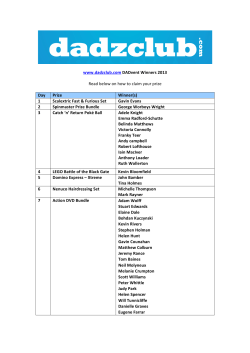
Logical Biology 5(4): 279-286, 2005 105 Years of Nobel
Logical Biology 5(4): 279-286, 2005 http://logibio.com © Truthfinding Cyberpress SCIENTIFIC AWARD ANALYSIS AND REPORT 105 Years of Nobel Prizes in Physiology/Medicine: Basic Facts and Key Statistics Shi V. Liu Eagle Institute of Molecular Medicine Research Triangle Park, North Carolina, USA E-mail: SVL@logibio.com (Received 2005-07-15; revised 2005-09-25, accepted 2005-10-01) (Published online 2005-10-02) HIGHLIGHT Since the first award in 1901, there have been 95 annual awards given to 182 individuals making important discoveries in physiology or medicine. As the first part of a series of examination and analysis of Nobel Prizes in Medicine or Physiology, the basic facts and some key statistics about the 95 awards and the 182 laureates are presented here. KEY WORDS Scientific award, Nobel Prize, Physiology, Medicine, Pioneering discovery 1. Introduction Before his death Alfred Nobel gave his final will of establishing prizes for discoveries or outstanding work made in five areas. Physiology or medicine is one of the original five “parts” for such Prizes. “The domain of physiology or medicine” of Nobel’s will was understood to encompass the theoretical as well as practical medical sciences. Nobel Prizes is no doubt the most prestigious awards for scientific research. The annual awarding events capture the attention of career scientists as well as public laymen. Once crowned with such an honor Nobel laureates became instant celebrities and their work became even more appreciated. Numerous papers and books have been written about the individual Nobel Prizes and their winners. However, it is rare to see collective presentation and systematic analysis of Nobel Prizes, especially over a large duration of time span. However, such collection and analysis would be valuable to observe the general features of the works and laureates Liu 105 YEARS OF NOBEL PRIZE 280 awarded with the Nobel Prize. It also serves as a yardstick to measure the major scientific advancement. In this communication, I have compiled a comprehensive database of all Nobel Prizes in physiology or medicine over its entire 105-years of history. Some basic facts and essential statistics are presented here as the first part of a series of articles on this topic. 2. The age profiles of the winners The ages of the 182 Nobel Prize winners at their time of winning the prizes, receiving the highest degrees (usually means PhD or a doctorate degree), and making the discoveries are presented in Fig. 1. The time span between making the discoveries and receiving the prizes for each winner is presented in Fig. 2. The basic statistics are presented in Table 1. From these presentations, it is clear that most winners earned their highest degrees at the age around 26 years old, making their discoveries around 39 years old, and collect the Nobel Prize around 56 years old. The average time interval between earning the degrees and receiving the prizes is about 30 years. The average time interval between making the discoveries and receiving the prizes is about 17 years. Some noticeable extremes are seen as the maximums and the minimums in Table 1. The youngest and the oldest age for winning a Nobel Prize winner in physiology/medicine are 32 and 87 years, respectively. The youngest and the oldest ages at making discoveries are 21 and 64 years, respectively. The shortest and the longest time span between making the discovery and receiving the prize are 1 year and 55 years, respectively. Because it is not so obvious to see the general trends over time in the plots of individual ages, a decade-level basic statistical analysis was performed and the results are presented in Fig. 3. From this analysis, it is apparent that the minimum age for receiving a Nobel Prize in physiology/medicine has a consistent increasing trend since 1950s. This increase was not matched by the level of increase in the minimum age for making the discovery. As to the degree-earning process, it appears that there was the least change in the entire century. The increased minimum age for receiving the Nobel Prize was well correlated with the increasing time span between making the discovery and receiving the prize, especially in the recent half of the century (Fig. 2). In a previous analysis over this half century alone, this feature was already noticed. A conclusion was reached that this really reflected a lost generation in winning the Nobel Prizes (Logical Biology 5: 200-202, 2005). Logical Biology 5 (3): 279-286, 2005 (http://logibio.com) ©Truthfinding Cyberpress Liu 105 YEARS OF NOBEL PRIZE 281 Fig. 1. The individual ages of Nobel Prize winners in physiology or medicine at their receiving of award, completion of highest degree, and making the discovery. Logical Biology 5 (3): 279-286, 2005 (http://logibio.com) ©Truthfinding Cyberpress Liu 105 YEARS OF NOBEL PRIZE 282 Fig. 2. Time span between making the discovery and collecting the Nobel Prize physiology or medicine. Table 1. Basic statistics of Nobel Prize winners for Physiology/Medicine in past 105 years *. 1901-2004 AVG Medium Mode Max Min Std Age at receiving highest degree 26.80 26 24 45 17 4.06 Age at making discovery Age at winning prize 39.20 39 40 64 21 7.67 56.82 56 55 87 32 11.17 Time span between receiving last degree and winning prize 30.03 29 27 63 1 11.71 Time span between making discovery and winning prize 17.63 15 13 55 1 10.34 *All 182 winners were included in the above calculations. Logical Biology 5 (3): 279-286, 2005 (http://logibio.com) ©Truthfinding Cyberpress Liu 105 YEARS OF NOBEL PRIZE 283 Fig. 3. Decade statistics of Nobel Prize winners in physiology or medicine on their ages at receiving the awards, completing their highest degrees, and making the discoveries. Logical Biology 5 (3): 279-286, 2005 (http://logibio.com) ©Truthfinding Cyberpress Liu 105 YEARS OF NOBEL PRIZE 284 3. The areas of the winning works Although Nobel Prize committee does not limit what areas and topics are eligible or more worthy of consideration, it appears that some areas and topics were heavily represented than others in the past 105-year history of Nobel Prize in physiology/medicine. There were also some temporal trend in the changing of areas and topics. For examples, discoveries in identifying infectious agents, understanding and treating infectious diseases won many of the early prizes (Table 2). Identifying key nutrients and using them for treating nutrient-deficient disorders also claimed many of the prizes in the first half century. Table 2. Areas and topics for past Nobel Prizes in physiology/medicine. General areas Specific topics (award year) Infectious agents, Diphtheria (1901), malaria (1902), lupus vulgaris (1903), disease and treatment tuberculosis (1905), protozoa (1907), typhus (1928), yellow fever (1951), cochlea (1961), dissemination (1976), prions (1997) Surgery Vascular suture (1912), leucotomy (1949), organ transplantation (1990) Medicine, nutrition, Vitamin (1929), anemia therapy (1934), vitamin C (1937), poisons antibacterial prontosil (1939), vitamin K (1943), penicillin (1945), DDT (1948), streptomycin (1952), synthetic inhibitors (1957), prostaglandins (1982) Methods, technology Electrocardiogram (1924), radioimmuno assay (1977), CT and instrumentation (1979), MRI (2003) Immunity Immunity (1908, 1919), anaphylaxis (1913), malaria inoculation (1927), immunological tolerance (1960), cell surface antigen (1980), antibody diversity (1987), cellmediated immunity (1996) Physiology Digestion (1904), respiration (1922), muscle heat production (1922), regulation of respiration (1938), heart catheterization (1956) Biochemistry/ Respiratory enzyme (1931), catalytic conversion of glycogen metabolism (1947), co-enzyme A, citric acid cycle (1953), oxidation enzyme (1955), cholesterol and fatty acid metabolism (1964) cholesterol metabolism (1985), protein phosphorylation (1992), G-proteins (1994) Hormone system Thyroid gland (1909), insulin (1923), hormone of anterior ٛ pituitary lobe (1947), adrenal cortex (1950), action of hormone (1971), monoclonal antibody (1984) Circulation system and Capillary regulation (1920), blood group (1930) blood Nervous system Structure (1906), junctions of neurons (1932), chemical transmission (1936), single nerve fiber (1944), interbrain cooperation (1949), ionic mechanisms (1963), Humoral Logical Biology 5 (3): 279-286, 2005 (http://logibio.com) ©Truthfinding Cyberpress Liu 105 YEARS OF NOBEL PRIZE 285 transmitter (1970), peptide hormone in brain (1977), cerebral functional specialization (1981), nitric oxide signaling (1998), signal transduction (2000) Vision, hearing, Dioptrics (1911), vestibular apparatus (1914), visual processes smelling (1967), information process (1981), odorant receptors in olfactory system (2004) Cancer/tumor/ Carcinoma (1926), mutation (1946), prostatic cancer and oncogenesis tumor-inducing virus (1966), oncogene (1989) Virus and virology Cultivation (1954), virus synthesis (1965), replication mechanism (1969), interaction between tumor virus and genetic material (1975) Heredity/genetics Chromosome (1933), genetic recombination (1958), RNA/DNA synthesis (1959), DNA structure (1962), genetic code and protein synthesis (1968), restriction enzyme (1978), mobile genetic element (1983), drug development principles (1988), split genes (1993) Cell and cell cycle Cell chemistry (1910), structure (1974), growth factor (1986), ion channels (1991), protein localization (1999), key regulator of cell cycle (2001), Development biology Organizer effect in embryo (1935), genetic control in early embryonic development (1995), organ development and programmed cell death (2002) The changing in the areas and topics also reflected the general progress in scientific research as our understanding of life went deeper and deeper from phenotypic physiology and biochemistry to genetic cell biology and molecular biology. However, several systems seemed maintained sustained interests of the Nobel Prize committee. For example, once a while, progresses made in understanding immunity were picked up for awarding. So was the advance in understanding and treating cancers. Something that touched the nerves, released some hormones, or affected some senses (vision, hearing or smelling) also seemed to be able to push the “right” buttons. Heredity, genetics, molecular biology and related virology appeared to be the heart of biology that harvested a significant Nobel Prizes in the recent half century. Cell biology and developmental biology appeared to be the home places for integrating biological information at the two different levels and appeared to be the current focus as the molecular era of biology is being replaced with the systematic (cellular or organismal) biology. 4. Conclusions The examination of the past 105 years of Nobel Prize in physiology and medicine revealed some basic age profiles for the Nobel Prize winners and some heavily represented areas of researches. The century long data showed that there was not much difference in terms of when the winners finished their education and start working on the discovery. However, there was apparently some increase in the minimal age to be awarded with a Nobel Prize. This increased time span between making discovery and collecting award was most obvious for the recent half of the century. This situation may Logical Biology 5 (3): 279-286, 2005 (http://logibio.com) ©Truthfinding Cyberpress Liu 105 YEARS OF NOBEL PRIZE 286 indicate the longer time required to assessing the value of the discoveries or the lack of better discoveries in recent time over the past time. If this latter situation is true, then it really reveals a very significant problem for our modern research system. The century-long view of Nobel Prize in physiology/medicine also revealed two “golden valleys” for young scientists to shine. One was in the 1920s where the youngest winner (32 years old when won the prize) and the shortest time-span between discovery and award (less than 2 years) was seen. The other was around 1960s where young scientists dominated the discoveries related with genetic materials and mechanisms. However, these good days for young scientists seemed gone. The question for all of us is how could we get it back? Logical Biology 5 (3): 279-286, 2005 (http://logibio.com) ©Truthfinding Cyberpress
© Copyright 2025









